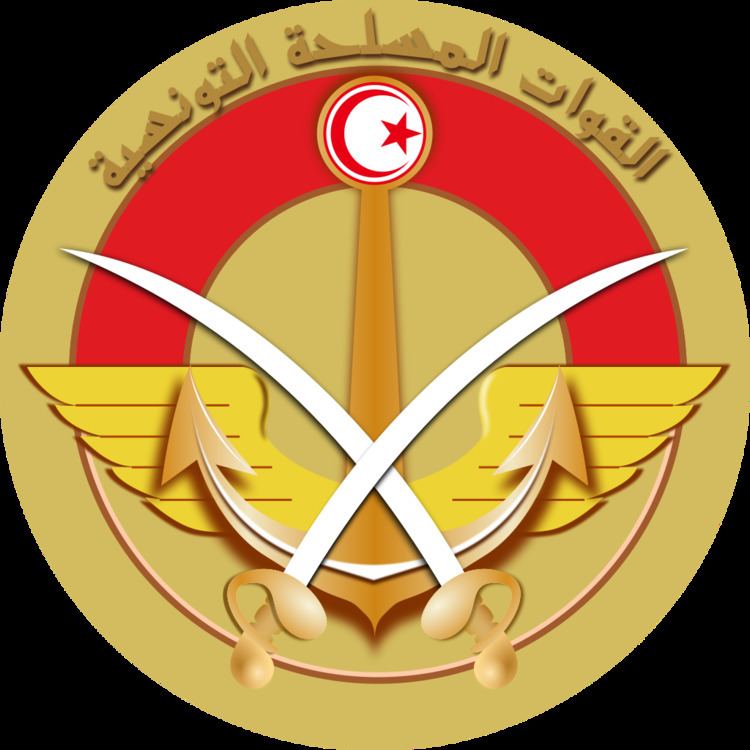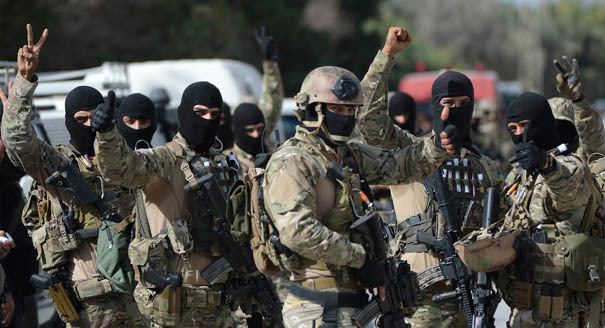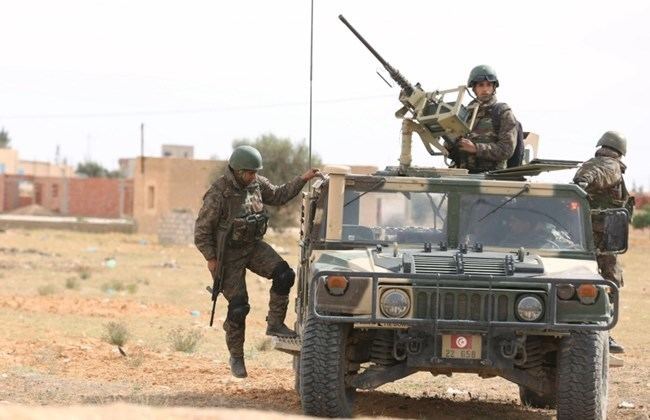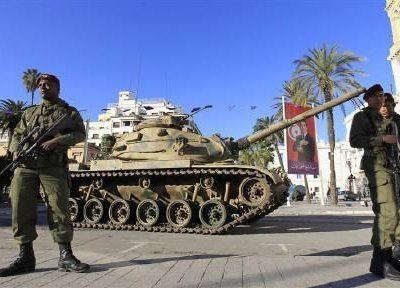Minister of National Defense Farhat Horchani Founded 24 June 1956 | Headquarters Tunis Active personnel 45,000 - 60,000 | |
 | ||
Commander-in-Chief President Béji Caïd Essebsi Chief of Staff Brigadier General Ismail Fathalli Similar Tunisian Air Force, Egyptian Armed Forces, Royal Moroccan Armed Fo, Portuguese Armed Forces, Libyan National Army | ||
Tunisian armed forces
The Tunisian Armed Forces (Arabic: القوات المسلحة التونسية) consist of the Tunisian Army, Air Force and Navy.
Contents
- Tunisian armed forces
- History
- Following independence
- The military and politics
- General Staff
- Tunisian Army
- Army Ranks
- Enlisted personnel
- Non Commissioned Officers
- Officers
- Air Force equipment
- Naval attacksearch and rescue helicopters
- Medium transport helicopters
- Light transport helicopters
- Missiles
- Navy equipment
- Patrol boats
- Aircraft
- Weapons of mass destruction
- References
As of 2012, Tunisia had an army of 40,500 personnel equipped with 84 main battle tanks and 48 light tanks. The Air Force had 4,000 personnel, 27 combat aircraft and 43 helicopters. The navy numbered 4,800 operating 25 patrol boats and 6 other craft. Paramilitary forces consisted of a 12,000-member national guard. Tunisia participates in United Nations peacekeeping efforts in the DROC (MONUSCO) and Côte d'Ivoire. Previous United Nations peacekeeping deployments for the Tunisian armed forces have included Cambodia (UNTAC), Namibia (UNTAG), Somalia, Rwanda, Burundi, Ethiopia/Eritrea (UNMEE), and the 1960s mission in the Congo, ONUC.

The former minister of defence was Rachid Sabbagh.
History

The modern Tunisian army was formed in 1831 by Al-Husayn II ibn Mahmud. During the period of the French Protectorate (1881–1956) Tunisians were recruited in significant numbers into the French Army, serving as tirailleurs (infantry) and spahis (cavalry). These units saw active service in Europe during both World Wars, as well as in Indo-China prior to 1954. The only exclusively Tunisian military force permitted under French rule was the Beylical Guard.
Following independence

On June 30, 1956, the Tunisian army was officially founded by decree, in the form of a combined-arms regiment. The necessary equipment was made available to the young state from French stocks. The new army initially comprised 25 Tunisian officers, 250 NCOs and 1,250 men transferred from French Army service, plus 850 former members of the Beylical Guard. Approximately 4,000 Tunisian soldiers continued in French Army service until 1958, when the majority transferred to the Tunisian Army, which reached a strength of over 6,000 that year.

Intakes of conscripts for military service, made mandatory in January 1957, plus the recall of reservists allowed the army to grow to twelve battalions numbering 20,000 men by 1961. Sixty per cent of those troops were deployed for border monitoring and defense duties.
Tunisian units first saw action in 1958 after French intrusions into the south in pursuit of National Liberation Army (Algeria) fighters. In 1960 Tunisian troops served with the United National Peacekeeping Force in the Congo. 1,020 troops from the Tunisian Armed Forces were amongst the first UN troops to arrive in the Congo, by 20 July 1960. In 1961 clashes occurred with French forces based at Bizerte. More than 600 men fell in battle against the French forces. The French evacuated the base after subsequent negotiations with the Tunisian Government.
The Tunisian Navy, founded in 1958, received its first ship in the fall of 1959. The Air Force acquired its first combat aircraft in 1960 . While the Tunisian armed forces obtain equipment from several sources, the United States remains the largest single supplier. Officer and specialist training for Tunisian personnel was formerly undertaken in French and American military academies. Tunisian trainees are now gradually being assigned to newly established military schools within the country.
The January 10, 1957, a law prohibits any military officer to be a member of a group or a political party. However, after 7 November 1987 when the former Prime Minister, General Zine el-Abidine Ben Ali took power senior officers such as Abdelhamid Escheikh and Mustapha Bouaziz took up ministerial appointments.
On April 30, 2002, at around 18.15, the direction of the Army - Brigadier General Abdelaziz Skik who led the Tunisian contingent to Cambodia, two colonels - majors, three colonels, four majors, two lieutenants and a sergeant-major - disappeared in a helicopter crash near the town of Medjez el-Bab.
Tunisia has contributed military forces to United Nations peacekeeping missions, including an army company to the United Nations Assistance Mission for Rwanda (UNAMIR) during the Rwandan Genocide. In his book Shake Hands with the Devil, Canadian force commander Roméo Dallaire gave the Tunisian soldiers high credit for their skills and effort in the conflict and referred to them as his "ace in the hole".
During the 2011 Libyan civil war, Tunisian forces, mostly border guards, saw some limited action when fighting between Libyan rebels and loyalist soldiers spilled over the border.
The military and politics
The Library of Congress Country Study says:
His exclusive power to promote military officers has been among the strongest components of Bourguiba's control over the armed forces. From independence, high-ranking officers—general staff and senior commanders in particular—have been carefully selected for their party loyalty more than for their professional experience and competence. This began in the late 1950s when the president dismissed those officers who had trained in the Middle East and who might therefore have been expected to sympathize with the militant Pan-Arab policies of Egypt's Nasser. The hand-picked senior officers, in turn, carefully screened all officers who were considered for positions of authority in line units to ensure that antiregime elements did not pose potential threats at any level of the military establishment.
As a result of these promotion policies, the Tunisian officer corps took on a very homogeneous character that only began to break down in the 1970s. Senior officers have been generally representative of Tunisia's economically and politically dominant families from the north, the coastal areas, and the major cities. Although military men have been kept from operating major business ventures or holding political office while in uniform, it has been common for family members to be prominent in business or in the Destourian political movement. Generally Western and Francophile in outlook, tied by kinship to the country's upper socioeconomic stratum, and personally familiar with leading figures in the PSD, high-ranking Tunisian officers must be classed as part of the national elite.
General Staff
In accordance with Article 44 of the constitution, the supreme commander of the armed forces is the President of the Republic of Tunisia.
In December 2010, the staff is composed as follows: Chief of Staff of the Army corps is the General Rashid Ammar, one of the Air Force is Brigadier General Taieb Lajimi and that the navy is Rear Admiral Mohamed Khamassi. In April 2011, Ammar became chief of staff inter-armed.
The Inspector General of the armed forces is Rear Admiral Tarek Faouzi Larbi, the Director of Military Engineering is Brigadier General Mohammed Hedi Abdelkafi and the director of military security Brigadier General Ahmed Chabir.
Tunisian Army
The Tunisian Army is 27,000 strong and is composed essentially of:
Army Ranks
with editing the source
Enlisted personnel
Non-Commissioned Officers
Officers
Air Force equipment
The Tunisian Air Force is equipped with 10 Northrop F-5E Tiger II and two Northrop F-5F Tiger II. These form 15 Squadron at Bizerte-Sidi Ahmed Air Base. It also includes 12 Aero L-59T, as well as three Aermacchi MB-326K (combat capable) as well as 4 MB-326B, and 3 MB326L. Previously up to 8 Aermacchi MB-326B, 7-16 Aermacchi MB-326KT, and 4 Aermacchi MB-326LT were in service.
The IISS Military Balance 2013 lists six Lockheed C-130B Hercules, one Lockheed C-130H Hercules, five G-222s, three Let L-410UVP Turbolet (all assigned to one transport squadron) plus a liaison unit with two S-208A. Other reported transport aircraft include one Boeing 737-700/BBJ, two Dassault Falcon 20, and two Lockheed C-130J-30 Super Hercules.
Reported attack helicopters include four Hughes MD 500 Defenders, and 7-8 SNIAS SA-342 Gazelle.
Reported training/COIN and liaison aircraft include 12 SIAI Marchetti SF.260WC Warriors and 9 SIAI-Marchetti SF-260C, as well as 4 SIAI-Marchetti S.208A/M and one Reims F406.
Apart from Bizerte Sidi-Ahmed, there are military airfields reported at Bizerte (La-Kharouba), Gabes, Gafsa, and Sfax.
Naval attack/search and rescue helicopters
Medium transport helicopters
Light transport helicopters
Missiles
Navy equipment
Established in 1959, the Marine nationale tunisienne (Tunisian National Navy) initially received French assistance, including advisory personnel and several small patrol vessels. On 22 October 1973, the U.S. Edsall-class destroyer escort USS Thomas J. Gary (DE-326) was decommissioned in ceremonies at the Quai d'Honneur, Bizerte. Moments later, the ship was commissioned by the Tunisian Navy as the President Bourgiba. In the mid-1980s the force included President Bourguiba, two United States-built coastal minesweepers, and a variety of fast-attack and patrol craft. The most important additions to the fleet in the 1980s were three La Combattante III class fast attack craft armed with Exocet surface-to-surface missiles. Apart from these vessels, however, most of the fleet's units were old and capable of little more than coastal patrol duties.
During the 1960s and 1970s the navy was primarily involved in combating the smuggling of contraband, the illegal entry of un- desirable aliens, and unauthorized emigration as well as other coastal security activities. In these matters the overall effort was shared with agencies of the Ministry of Interior, especially the customs agents and immigration personnel of the Surete Nationale.
President Bourgiba suffered a major fire on 16 April 1992 and later left operational service.
Today the Tunisian Navy reportedly has bases at Bizerte, Kelibia, La Goulette, and Sfax. Formerly reported in service were six Kondor-II class minsweepers of 635 tons, equipped with 3x2x25mm Guns. However none were listed in service by the IISS Military Balance 2013. Also formerly in use were MBDA MM-40 Exocet and Nord SS-12M surface-to-surface missiles.
Fast attack craft and gunboats include:
Patrol boats
Landing craft and auxiliary vessels include one LCT-3 class LCT, one Robert Conard class 63.7m Survey vessel (NHO Salammbo), one Wilkes class (T-AGS-33) survey ship (NRF Khaireddine), two El Jem class training ships (ex A 5378 Aragosta and A 5381 Polipo delivered by Italian Navy on 17 July 2002), one Simeto class Tanker ( Ain Zaghouin - ex A 5375 delivered by Italian Navy on 10.7.2003) and one White Sumac 40.5m class, one diver training vessel Zarzis.
Aircraft
Weapons of mass destruction
No known nuclear activity. Signatory to the Nuclear Non-Proliferation Treaty (NPT).
No known chemical weapons activity. Party to the Chemical Weapons Convention (CWC).
No known biological weapons activity. Party to the Biological Weapons Convention (BWC).
